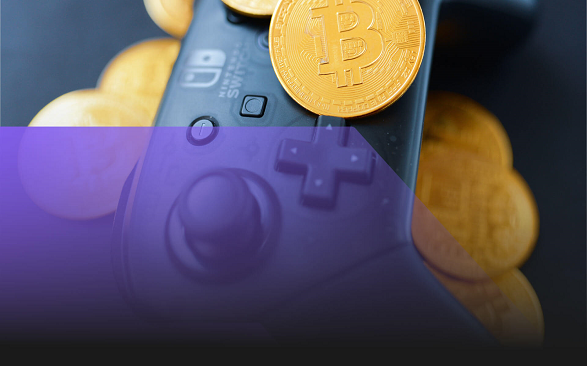You may have heard about or come across play-to-earn games. Play-to-earn games are not just online video games. The introduction of online video games greatly boosted the entertainment industry. Since the inception of Tennis for Two in 1958, video gaming has taken the world by storm, with games like League of Legends, Fortnite, and Minecraft being played by millions of gamers around the globe. Except players of these video games decide to bet, earning from playing video games was not a part of the game.
But thanks to blockchain technology and the many play-to-earn games or ecosystems we have today, the days people played video games just for fun are over. If you are still playing online video games that offer no rewards or monetary benefits in this present era, you may have been left behind or in the dark.
Blockchain technology is positively impacting the gaming industry by enabling players to earn money from playing games. This became possible following the introduction of cryptocurrency and digital assets into games. Notably, these in-game assets can be traded on secondary marketplaces for real money. Therefore, with the help of blockchain technology, gamers have shifted from just playing for fun to playing to earn.
One can then say that the GameFi—game and finance—innovation is now the real deal as the blockchain gaming industry continues to expand by the day. Did you know that the global gaming market size is expected to reach $58.8 billion by 2028 and is predicted to grow at a Compound Annual Growth Rate (CAGR) of 26.8%, at the time of forecast? This amazing statistic clearly shows the growing popularity and potential of blockchain gaming.
In this article, we dive deep into the play-to-earn ecosystem. We will examine how play-to-earn platforms work, the benefits they offer, and the challenges and risks associated with them. So read on to learn more about the play-to-earn ecosystem.
Related: What is Blockchain Technology? Meaning, Types, and Use Cases
Understanding Play–to–Earn Ecosystems
The play-to-earn innovation is an exciting development as its emergence has changed the narratives in the world of online or video gaming. As the name implies, this concept allows people to earn digital assets such as cryptocurrencies or non-fungible tokens (NFTs) as rewards for playing blockchain-based games. This is the exact opposite of how conventional Web 2.0 gaming works. Players get no rewards for playing web 2.0 games, thus restricting it to a fun- or leisure-only activity. But play-toearn ecosystems powered by blockchain technology do not only provide entertainment but also serve as a revenue source for gamers.
Over the years, numerous platforms supporting the play-to-earn ideology have emerged. Notable among these blockchain-based gaming platforms and decentralized applications (dApps) are Axie Infinity, Enjin, The Sandbox, Splinterlands, and Sorare, amongst others. More so, play-to-earn ecosystems present different genres of games, including action games, strategy games, and role-playing games for players to choose from. To note, all these categories of games offer users a wide variety of rewards, including in-game assets, non-fungible tokens (NFTs), digital collectibles, and cryptocurrencies.
With these play-to-earn ecosystems, players can earn rewards in many ways.
This could be completing levels, winning tournaments, reaching milestones, or participating in special events on a particular platform. In Axie Infinity, for example, players can buy, breed, and pit Pokémon-like characters (called Axies) against each other for the project’s in-game currency called Smooth Love Potions (SLPs). SLP tokens can be exchanged for other cryptocurrencies or fiat currencies as the case may be.
Top play-to-earn games you should know
The gamefi industry continues to expand with the introduction of many unique blockchain-based games. In no particular order, we discuss some of the most popular and widely adopted play-to-earn games in the industry today.
- Axie Infinity
Axie Infinity is a blockchain-based game that allows players to collect, breed, and battle fantastical creatures called Axies. The game’s native token, AXS, is used to purchase and trade Axies and participate in in-game activities and events. Axie Infinity has a strong community of players actively involved in the breeding and trading of Axie. By January 2023, the Axie Infinity project had a market capitalization of $1,062,890,823 and 432,001 active players at the time of writing. The all-time high of AXS is $135.35 per token in the bullish market of November 2021.
- Enjin
Enjin is another play-to-earn gaming platform that enables developers to create and manage their virtual worlds and games. The Enjin ecosystem’s native currency, Enjin Coin (ENJ), is used to purchase in-game items and assets. ENJ is a utility token that helps in facilitating transactions on the Enjin platform. More so, the Enjin platform offers a variety of games, including action games, role-playing games (RPG), and strategy games amongst others. Popular games on the platform include 9Lives Arena, Age of Rust, and Six Dragons. At the time of writing, Enjin Coin is the 5th-largest Ethereum-based ERC-20 token, having a market cap of $480,256,788. ENJ’s all-time high is $3.65 per token which it attained in November 2021. This price has since fallen to less than a dollar at the time of writing.
- The Sandbox
Rolled out in late 2020, The Sandbox is a decentralized, community-driven gaming ecosystem where creators can share and monetize voxel assets and gaming experiences on the Ethereum blockchain. Notably, the Sandbox blockchain gaming platform consists of three integrated products. These products are Voxel Editor (VoxEdit), marketplace, and game maker. Jointly, these three products provide a comprehensive experience for user-generated content (UGC) production on The Sandbox platform.
Also, The Sandbox project employs four token types (SAND, LAND, ASSET, GAME). This model is to ensure a circular economy between all the types of users (players, creators, curators, and land owners) who interact with the blockchain-based platform.
SAND, an ERC-20 token, is the platform’s main utility token. It is used as the basis for all transactions and interactions on The Sandbox gaming platform. At the time of writing, SAND has a market cap of $1,175,233,308.SAND’s all-time high price so far is $4.78 per token at the peak of the crypto-market bull run in November 2021
- Sorare
Sorare is a unique gamefi platform that provides collectible and tradable non-fungible tokens (NFTs) for football, basketball, and soccer fans. The platform allows players to collect, trade, and officially use licensed collectible digital player cards. The platform’s native token, the Sorare Token (SORA), is used to buy and trade NFTs on the platform. By 2023, Sorare hit a market cap of approximately $6,216,338. Sorare is steadily growing in terms of the number of users and the number of transactions on the platform.
Notably, Sorare has been adopted by some of the biggest football clubs in the world. The football clubs include Paris Saint-Germain, Juventus, and West Ham United.
- Decentraland
In a nutshell, Decentraland is an Ethereum-based gamefi platform and virtual world that allows users to create, explore, and monetize their own virtual reality experiences. The platform’s native token, MANA, is used to buy and trade virtual LAND, as well as participate in in-game events. Decentraland has a strong community of users actively involved in creating and exploring virtual worlds.
MANA reached its all-time high of $3.74 per coin in November 2021 but by 2023 had stumped to less than a dollar, according to Coinmarketcap data.
Read also: What are the top 5 blockchain projects you should know?
Benefits of Play and Earn Ecosystems to Gamers
Blockchain technology offers various benefits across many industries. The gaming industry is no exception. Play-to-earn ecosystems presents many advantages over traditional gaming ecosystems. Here are some of the key benefits:
- Source of Income: The play-to-earn model is changing the face of the gaming industry. In the past, people played games for fun or to experience stories. Later, multiplayer games emerged where players could play together or against each other as well as buy and sell items. But these items were not worth real money. Blockchain-powered play-to-earn ecosystems offer players value for the time and energy expended in playing games. With blockchain gaming, players can generate steady incomes.
- Community Building: Play-to-earn (P2E) ecosystems also facilitate community building and networking among players. With blockchain games, players can communicate and trade with each other, creating a sense of community and a shared experience. Additionally, the decentralized nature of blockchain allows for the creation of decentralized autonomous organizations (DAOs) that can manage and fund gaming projects based on community participation.
Challenges and Risks
One of the biggest challenges for blockchain-gaming platforms is scalability. Blockchain technology is still new and is currently developing. Hence, some play-to-earn games cannot yet handle a high volume of transactions or activities per second. This can result in slower transaction times and high fees on some play-and-earn ecosystems. Consequently, this could be a major impediment for existing and prospective players.
Another risk is the volatility of cryptocurrencies. The value of digital assets fluctuates wildly, making it difficult for players to maximize the full value of their rewards, if the price of these digital assets fall. Also, the volatility of cryptocurrencies can make it difficult for platforms to price in-game items and assets.
Read also: What is Cryptocurrency?
Final Words
Blockchain gaming is a fast-growing niche and one of the most clever technological advancements in the world today. Though play-to-earn games are still in their infancy, it has hugely benefited many adopters or gamers since inception.
Today, we have countless play-to-earn games or ecosystems. Have you tried out any of these blockchain-based, play-to-earn games? You may want to join the growing community of players earning from just playing the games they love. Interestingly, you don’t have to be an expert to start taking advantage of blockchain gaming. But you must master your craft to increase your chances of earning well.
Read also: Understanding the Metaverse and Top Metaverse Coins in the Crypto Market
Credit: Ndianabasi Tom
A crypto journalist and content writer who has been talking about cryptocurrency and blockchain technology since 2018, Ndianabasi is a Writer at Crypto Asset Buyer (CAB).
Discover more from Crypto Asset Buyer
Subscribe to get the latest posts sent to your email.




